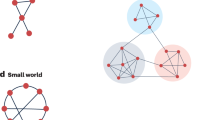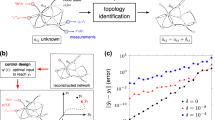Abstract
The ultimate proof of our understanding of natural or technological systems is reflected in our ability to control them. Although control theory offers mathematical tools for steering engineered and natural systems towards a desired state, a framework to control complex self-organized systems is lacking. Here we develop analytical tools to study the controllability of an arbitrary complex directed network, identifying the set of driver nodes with time-dependent control that can guide the system’s entire dynamics. We apply these tools to several real networks, finding that the number of driver nodes is determined mainly by the network’s degree distribution. We show that sparse inhomogeneous networks, which emerge in many real complex systems, are the most difficult to control, but that dense and homogeneous networks can be controlled using a few driver nodes. Counterintuitively, we find that in both model and real systems the driver nodes tend to avoid the high-degree nodes.
This is a preview of subscription content, access via your institution
Access options
Subscribe to this journal
Receive 51 print issues and online access
$199.00 per year
only $3.90 per issue
Buy this article
- Purchase on SpringerLink
- Instant access to full article PDF
Prices may be subject to local taxes which are calculated during checkout





Similar content being viewed by others
References
Kalman, R. E. Mathematical description of linear dynamical systems. J. Soc. Indus. Appl. Math. Ser. A 1, 152–192 (1963)
Luenberger, D. G. Introduction to Dynamic Systems: Theory, Models, & Applications (Wiley, 1979)
Slotine, J.-J. & Li, W. Applied Nonlinear Control (Prentice-Hall, 1991)
Kelly, F. P., Maulloo, A. K. & Tan, D. K. H. Rate control for communication networks: shadow prices, proportional fairness and stability. J. Oper. Res. Soc. 49, 237–252 (1998)
Srikant, R. The Mathematics of Internet Congestion Control (Birkhäuser, 2004)
Chiang, M., Low, S. H., Calderbank, A. R. & Doyle, J. C. Layering as optimization decomposition: a mathematical theory of network architectures. Proc. IEEE 95, 255–312 (2007)
Wang, X. F. & Chen, G. Pinning control of scale-free dynamical networks. Physica A 310, 521–531 (2002)
Wang, W. & Slotine, J.-J. E. On partial contraction analysis for coupled nonlinear oscillators. Biol. Cybern. 92, 38–53 (2005)
Sorrentino, F., di Bernardo, M., Garofalo, F. & Chen, G. Controllability of complex networks via pinning. Phys. Rev. E 75, 046103 (2007)
Yu, W., Chen, G. & Lü, J. On pinning synchronization of complex dynamical networks. Automatica 45, 429–435 (2009)
Marucci, L. et al. How to turn a genetic circuit into a synthetic tunable oscillator, or a bistable switch. PLoS ONE 4, e8083 (2009)
Strogatz, S. H. Exploring complex networks. Nature 410, 268–276 (2001)
Dorogovtsev, S. N. & Mendes, J. F. F. Evolution of Networks: From Biological Nets to the Internet and WWW. (Oxford Univ. Press, 2003)
Newman, M., Barabási, A.-L. & Watts, D. J. The Structure and Dynamics of Networks (Princeton Univ. Press, 2006)
Caldarelli, G. Scale-Free Networks: Complex Webs in Nature and Technology (Oxford Univ. Press, 2007)
Albert, R. & Barabási, A.-L. Statistical mechanics of complex networks. Rev. Mod. Phys. 74, 47–97 (2002)
Tanner, H. G. in Proc. 43rd IEEE Conf. Decision Contr. Vol. 3. 2467–2472 (2004)
Lombardi, A. & Hörnquist, M. Controllability analysis of networks. Phys. Rev. E 75, 56110 (2007)
Liu, B., Chu, T., Wang, L. & Xie, G. Controllability of a leader–follower dynamic network with switching topology. IEEE Trans. Automat. Contr. 53, 1009–1013 (2008)
Rahmani, A., Ji, M., Mesbahi, M. & Egerstedt, M. Controllability of multi-agent systems from a graph-theoretic perspective. SIAM J. Contr. Optim. 48, 162–186 (2009)
Kim, D.-H. & Motter, A. E. Slave nodes and the controllability of metabolic networks. N. J. Phys. 11, 113047 (2009)
Mesbahi, M. & Egerstedt, M. Graph Theoretic Methods in Multiagent Networks (Princeton Univ. Press, 2010)
Motter, A. E., Gulbahce, N., Almaas, E. & Barabási, A.-L. Predicting synthetic rescues in metabolic networks. Mol. Syst. Biol. 4, 168 (2008)
Pastor-Satorras, R. & Vespignani, A. Evolution and Structure of the Internet: A Statistical Physics Approach (Cambridge Univ. Press, 2004)
Lezon, T. R., Banavar, J. R., Cieplak, M., Maritan, A. & Fedoroff, N. V. Using the principle of entropy maximization to infer genetic interaction networks from gene expression patterns. Proc. Natl Acad. Sci. USA 103, 19033–19038 (2006)
Lin, C.-T. Structural controllability. IEEE Trans. Automat. Contr. 19, 201–208 (1974)
Shields, R. W. & Pearson, J. B. Structural controllability of multi-input linear systems. IEEE Trans. Automat. Contr. 21, 203–212 (1976)
Lohmiller, W. & Slotine, J.-J. E. On contraction analysis for nonlinear systems. Automatica 34, 683–696 (1998)
Yu, W., Chen, G., Cao, M. & Kurths, J. Second-order consensus for multiagent systems with directed topologies and nonlinear dynamics. IEEE Trans. Syst. Man Cybern. B 40, 881–891 (2010)
Hopcroft, J. E. & Karp, R. M. An n5/2 algorithm for maximum matchings in bipartite graphs. SIAM J. Comput. 2, 225–231 (1973)
Albert, R., Jeong, H. & Barabási, A.-L. Error and attack tolerance of complex networks. Nature 406, 378–382 (2000)
Cohen, R., Erez, K., Ben-Avraham, D. & Havlin, S. Resilience of the Internet to random breakdowns. Phys. Rev. Lett. 85, 4626–4628 (2000)
Pastor-Satorras, R. & Vespignani, A. Epidemic spreading in scale-free networks. Phys. Rev. Lett. 86, 3200–3203 (2001)
Nishikawa, T., Motter, A. E., Lai, Y.-C. & Hoppensteadt, F. C. Heterogeneity in oscillator networks: are smaller worlds easier to synchronize? Phys. Rev. Lett. 91, 014101 (2003)
Erdős, P. & Rényi, A. On the evolution of random graphs. Publ. Math. Inst. Hung. Acad. Sci. 5, 17–60 (1960)
Bollobás, B. Random Graphs (Cambridge Univ. Press, 2001)
Barabási, A.-L. & Albert, R. Emergence of scaling in random networks. Science 286, 509–512 (1999)
Goh, K.-I., Kahng, B. & Kim, D. Universal behavior of load distribution in scale-free networks. Phys. Rev. Lett. 87, 278701 (2001)
Chung, F. & Lu, L. Connected component in random graphs with given expected degree sequences. Ann. Combin. 6, 125–145 (2002)
Maslov, S. & Sneppen, K. Specificity and stability in topology of protein networks. Science 296, 910–913 (2002)
Milo, R. et al. Network motifs: simple building blocks of complex networks. Science 298, 824–827 (2002)
Mézard, M. & Parisi, G. The Bethe lattice spin glass revisited. Eur. Phys. J. B 20, 217–233 (2001)
Zdeborová, L. & Mézard, M. The number of matchings in random graphs. J. Stat. Mech. 05, 05003 (2006)
Zhou, H. & Ou-Yang, Z.-c. Maximum matching on random graphs. Preprint at 〈http://arxiv.org/abs/cond-mat/0309348〉 (2003)
Callaway, D. S., Newman, M. E. J., Strogatz, S. H. & Watts, D. J. Network robustness and fragility: percolation on random graphs. Phys. Rev. Lett. 85, 5468–5471 (2000)
Boguñá, M., Pastor-Satorras, R. & Vespignani, A. Cut-offs and finite size effects in scale-free networks. Eur. Phys. J. B 38, 205–209 (2004)
Lovász, L. & Plummer, M. D. Matching Theory (American Mathematical Society, 2009)
Bauer, M. & Golinelli, O. Core percolation in random graphs: a critical phenomena analysis. Eur. Phys. J. B 24, 339–352 (2001)
Newman, M. E. J. Assortative mixing in networks. Phys. Rev. Lett. 89, 208701 (2002)
Pastor-Satorras, R., Vázquez, A. & Vespignani, A. Dynamical and correlation properties of the Internet. Phys. Rev. Lett. 87, 258701 (2001)
Acknowledgements
We thank C. Song, G. Bianconi, H. Zhou, L. Vepstas, N. Gulbahce, H. Jeong, Y.-Y. Ahn, B. Barzel, N. Blumm, D. Wang, Z. Qu and Y. Li for discussions. This work was supported by the Network Science Collaborative Technology Alliance sponsored by the US Army Research Laboratory under Agreement Number W911NF-09-2-0053; the Office of Naval Research under Agreement Number N000141010968; the Defense Threat Reduction Agency awards WMD BRBAA07-J-2-0035 and BRBAA08-Per4-C-2-0033; and the James S. McDonnell Foundation 21st Century Initiative in Studying Complex Systems.
Author information
Authors and Affiliations
Contributions
All authors designed and did the research. Y.-Y.L. analysed the empirical data and did the analytical and numerical calculations. A.-L.B. was the lead writer of the manuscript.
Corresponding author
Ethics declarations
Competing interests
The authors declare no competing financial interests.
Supplementary information
Supplementary Information
This file contains Supplementary Text and Data comprising: 1 Introduction; II Previous Work and Relation of Controllability to Other Problems; III Structural Control Theory; IV Maximum Matching; V Control Robustness and VI Network Datasets (see Contents list for full details), Supplementary Figures 1-11 with legends, Supplementary Table 1 and additional references. (PDF 972 kb)
Rights and permissions
About this article
Cite this article
Liu, YY., Slotine, JJ. & Barabási, AL. Controllability of complex networks. Nature 473, 167–173 (2011). https://doi.org/10.1038/nature10011
Received:
Accepted:
Published:
Issue Date:
DOI: https://doi.org/10.1038/nature10011
This article is cited by
-
Topology uniformity pinning control for multi-agent flocking
Complex & Intelligent Systems (2024)
-
Controllability in attention deficit hyperactivity disorder brains
Cognitive Neurodynamics (2024)
-
The BCL-2 inhibitor APG-2575 resets tumor-associated macrophages toward the M1 phenotype, promoting a favorable response to anti-PD-1 therapy via NLRP3 activation
Cellular & Molecular Immunology (2023)
-
From neural circuits to communities: an integrative multidisciplinary roadmap for global mental health
Nature Mental Health (2023)
-
Statistical control of structural networks with limited interventions to minimize cellular phenotypic diversity represented by point attractors
Scientific Reports (2023)



